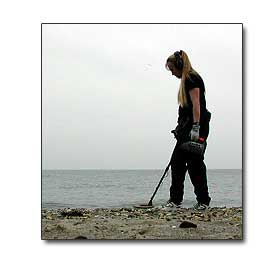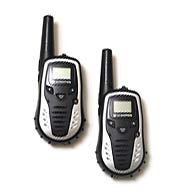Metal Detecting Techniques
How to Grid the Beach Metal Detecting Tip
Gridding the Beach
How many of you have heard of gridding the beach? Gridding
the beach is a term metal detectorists use to cover a small area of a beach, and at the same time add more finds to their pouch. It's easy to do. Instead of going to a beach and trying to cover the whole area in a couple of hours, which by the way, is called random searching, you pick out a location, that has been well traveled, or where you can tell many people have congregated, and you begin a search pattern.
Types of Gridding Patterns
 There are three patterns you can choose from. First, there is a straight pattern. A straight pattern is where you start from the high beach line and walk toward the low tide line, then you step a foot over, turn around, and walk back up to the high bank line where you started, and continue doing this for as long as you want to detect. Go slowly, and try to overlap your swings. If you can mark your trail behind you by dragging your sand scoop or shuffling your feet along, you can keep track of the area you have covered.
There are three patterns you can choose from. First, there is a straight pattern. A straight pattern is where you start from the high beach line and walk toward the low tide line, then you step a foot over, turn around, and walk back up to the high bank line where you started, and continue doing this for as long as you want to detect. Go slowly, and try to overlap your swings. If you can mark your trail behind you by dragging your sand scoop or shuffling your feet along, you can keep track of the area you have covered.
The second pattern is similar to the straight pattern. It is a sideways straight pattern, where you detect sideways at the high bank line, turning after you go 12 feet or so, stepping a foot over, turning, and overlapping your swings as you work your way back, and down to the low tide line.
The third pattern is called a circular pattern. If you are on a large beach, just go to the center of the beach, and when you locate your first target begin a circular pattern, you won't have to step over a foot every time, because the circle size increases as you go around. This is Carol's favorite way of detecting.
We were detecting in the water a couple of years ago at a beach in Massachusetts. A detectorist showed up, saw us in the water, and began detecting the beach. We watched him as he gridded the whole beach, leaving his lines to mark his way. When he was finished he left. About an hour later, two other detectorists showed up, saw us in the water, looked at the beach, and saw that it had been gridded. What did they do? They left, because they saw the lines, and they knew they wouldn't find anything.
Benefits
Did you know that you can find more in a 12 foot by 12 foot area, than you can by randomly zigzagging across a whole beach? One of the benefits of gridding a beach is, you don't wear yourself out finding nothing in the process. You'll find more, and you'll leave your mark for other detectorists. If you go to a beach, and see markings that appear to be straight lines or circular lines, you will know automaticly that someone has gridded that area, and you are not going to find much. So try to find an area to grid that he didn't get to. Mark yourself out an area, so you know where you're detecting. It takes concentration, but you'll be satisfied knowing that you didn't miss anything.
Something New
 We added something new to our metal detecting accessories a couple of weeks ago. We were in Walmart and saw some walkie talkies, and both of us were thinking the same thing, what a good use these could be for our hobby.
We added something new to our metal detecting accessories a couple of weeks ago. We were in Walmart and saw some walkie talkies, and both of us were thinking the same thing, what a good use these could be for our hobby.
When we first started detecting we detected together because we only had one metal detector. After a couple of months we thought, If we had another metal detector, we could find twice as much stuff! The only problem was, we each had to do our own recovery of targets, and we didn't get to see so much of each other. We would detect for an hour or so, and then try to find each other to compare our finds. We have been detecting like this for several years now.
For example, the day before we bought the walkie talkie's, we went to a new park and was detecting in separate areas. The beach was sort of at an odd angle, and there was also woods nearby. I headed toward the woods by a waterfall, she on the other hand, went towards the waterline in the fishing area adjacent to the beach. It started getting hot, and I was getting hungry and it would have been nice if I could have just called her to find out what she was finding, because it would determine whether or not we stayed. The problem was I had to try to find her.
Can't Get Lost
When we go detecting it seems we are always looking for each other, and wondering what each other is finding. It's always helps to know what were finding, because if one person is doing good, and the other person isn't then it is an encouragement to the other person that stuff is there.
Anyway, when we saw the walkie talkie's, it was a great find. We took them home and practiced talking on them from room to room, and checked out the channels. They worked great, and we couldn't wait to get to a beach to try them out.
The First Hunt
That's exactly what we did even though it was getting towards dark. We got in the car and headed to the nearest beach. It was totally dark by the time we got there and real foggy. We couldn't see 20 feet ahead of us. We checked the walkie talkies to make sure they were still working, and I took off to the far end of the beach where I usually locate some silver. She kind of lagged behind, yet was heading in my direction. After a few feet we couldn't see each other anymore, this was a perfect test for our new walkie talkies.
After about 20 minutes detecting in the dark, I located a silver quarter and was thrilled to be able to relay this information to her. Then she radios back and says, Cool, I'm on my way.
In ConclusionWe found that the walkie talkies helped alot in keeping contact with each other while metal detecting, and would recommend them highly if you are detecting with a partner. They are very affordable, and the ones we bought have a six mile radius, and a headset is included which Carol puts on before she puts her detector headphones on. I may even wire mine to my detector headphones.